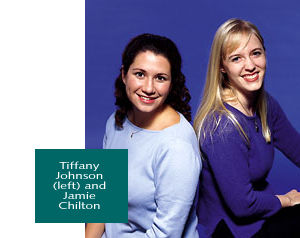EMORY
UNIVERSITY AND GEORGIA TECH
joined forces this fall with the inauguration of a joint Ph.D.
program in biomedical engineering. The aim of the new program,
which enrolled its first nine students in August, is to educate
a “new breed” of biomedical engineers, says Ajit P.
Yoganathan, associate chair.
“Currently
this field is dominated by engineers who have learned biology
on the side,” he says. “The motivation behind our
program is our belief that this field should be driven by the
biological sciences–that engineering is really just an
application or a method for solving problems in the biological
sciences.”
 With
that motivation in mind, the program’s faculty has pulled
together a curriculum that integrates biology “from day
one,” Yoganathan says. Another distinguishing characteristic
is that the program recruits equal numbers of students with
undergraduate degrees in life sciences and engineering–the
goal being that students learn from one another as well as from
the faculty. Most other biomedical engineering degree programs
won’t consider candidates with a background in biology
or chemistry, says Yoganathan, for fear that the students won’t
be up to the quantitatively rigorous coursework required for
a Ph.D. in engineering.
With
that motivation in mind, the program’s faculty has pulled
together a curriculum that integrates biology “from day
one,” Yoganathan says. Another distinguishing characteristic
is that the program recruits equal numbers of students with
undergraduate degrees in life sciences and engineering–the
goal being that students learn from one another as well as from
the faculty. Most other biomedical engineering degree programs
won’t consider candidates with a background in biology
or chemistry, says Yoganathan, for fear that the students won’t
be up to the quantitatively rigorous coursework required for
a Ph.D. in engineering.
“We
believe differently. We believe that you recruit bright students,
and they can learn quantitative and analytical problem solving,”
he says.
Five
years from now, the program’s first graduates will be able
to devise technological solutions to real-world medical problems
that they understand down to the cellular level.
Tiffany
L. Johnson and Jamie M. Chilton, two students who entered the
program this fall (eight of the nine students in the inaugural
class are women), say the program’s broad perspective was
its greatest attraction.
Johnson,
who earned a bachelor’s degree in chemical engineering
at the University of Virginia this spring, intends to concentrate
her doctoral work on tissue engineering.
Chilton
holds a degree in biochemistry from Agnes Scott College and
is interested in genetic or neuroengineering. She has previously
contributed to a DNA cloning research project at Emory.
“I
wanted broad exposure to the full field,” says Johnson.
“This was the only program that gave me the opportunity
to be at a medical school too. Engineers spend all our time
with beams and particles, and it’s good to be around doctors
and people who understand the medical side.”
Emory’s
School of Medicine and the College of Engineering at Georgia
Tech jointly created the Department of Biomedical Engineering
in 1997 to facilitate the flow of research between the two institutions.
To chair the biomedical engineering department, the institutions
recruited Don P. Giddens from his deanship at the Johns Hopkins
School of Engineering. The department currently has ten faculty
members, and Giddens intends to recruit an additional seventeen
full-time faculty over the next five to six years.
The
influx of new faculty with biomedical expertise and students
with a quantitative bent will have a far-reaching effect on
the quality of graduate-level academics at Emory, says Giddens.
“Most
certainly the other life sciences at Emory will benefit, because
they’ll be able to attract graduate students who want to
dabble in the courses offered through the biomedical program,”
he says. “And [Emory’s other graduate life sciences
programs] will be able to recruit the kind of faculty who want
to work with colleagues with quantitative expertise.”
Both
universities will confer doctoral degrees to graduates of the
program. Graduate students may choose one of five concentrations:
cardiovascular mechanics and biology, cellular and tissue engineering,
neurosciences and neuroengineering, biomedical imaging, and
biomedical modeling and computing. Research goals range from
seeking new ways to prevent heart disease, to creating biologically
based replacement parts for the human body or finding better
ways to deliver pharmaceuticals to specific areas of the body.
“All aspects of this field fascinate me,” says Chilton.
“I just want to do something great. Anything I can do to
help people is my goal.”—Sharla A. Stewart